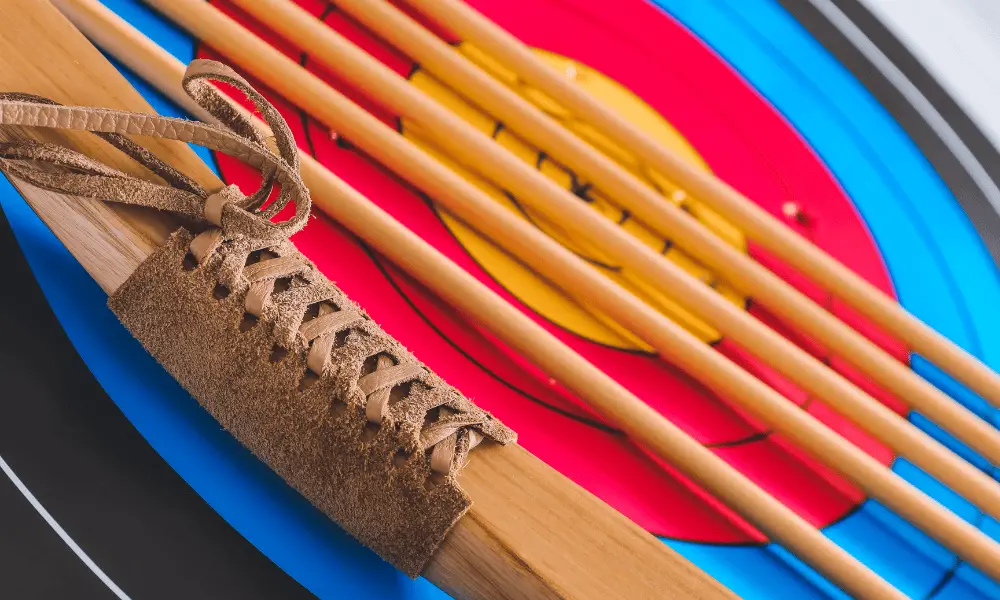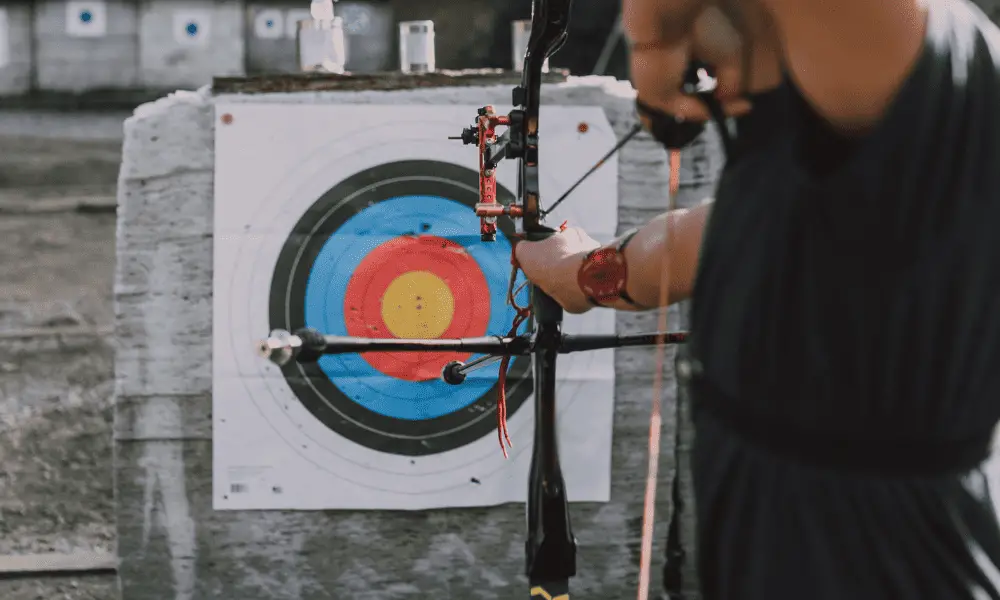Imagine transforming your backyard into a sanctuary where focus, precision, and relaxation unite, allowing you to hone your archery skills in the comfort of your own home.
With careful planning and preparation, creating an archery range in your backyard is not only possible but can also offer numerous benefits for both beginner and experienced archers alike.
In this article, we’ll guide you through designing a safe and efficient range layout, choosing the right equipment and targets, establishing safety guidelines and precautions, as well as suggesting fun drills for skill improvement.
You understand that practice makes perfect – but what if practicing at home could elevate your passion for archery to new heights?
Whether you’re seeking an enjoyable recreational activity or pursuing mastery in this ancient sport, knowing how to safely set up a backyard range will help you improve faster while having more fun.
Designing a Safe and Efficient Range Layout

So, you’re looking to design a safe and efficient range layout for archery practice in your backyard, huh?
That’s great! Archery is an excellent way to improve focus, strength, and coordination while having fun at the same time.
To get started, you’ll want to take into consideration backyard zoning and range maintenance. These two factors are crucial in ensuring that your archery range is both safe for you and those around you as well as easy to maintain.
When planning out your backyard archery range layout, first determine the available space and any obstacles that could pose potential hazards. You’ll need a clear shooting lane with ample room behind the target for stray arrows or overshoots.
Also, consider what might be beyond your property line; it’s essential to ensure that no one will be put at risk by errant shots.
In addition to safety concerns, think about how much time and effort you’re willing to put into maintaining your range – clearing debris, mowing grass, or trimming plants can all impact not only the aesthetics of the area but also its usability.
Now that you’ve taken zoning requirements and maintenance into account when designing your backyard archery range layout, go ahead and create a shooting area tailored specifically to your needs!
Choose appropriate targets based on skill level, set up backstops or netting systems if necessary, and establish boundaries with stakes or markers so everyone knows where they should stand while shooting.
With these steps completed, you’ll have yourself a functional and enjoyable outdoor archery practice space that can bring hours of entertainment while improving your skills!
Choosing the Right Equipment and Targets

You’ll want to ensure you’ve got the right gear and targets for a successful session, making every shot count! Bow selection and arrow types are crucial components of your archery setup.
When choosing a bow, consider factors such as draw weight, draw length, and the type of bow.
For arrows, it’s essential to select the appropriate spine (or stiffness) based on your bow’s specifications. Don’t forget about safety equipment like an arm guard and finger tab or release aid.
| Equipment | Description |
|---|---|
| Bow | Wear an arm guard to protect against string slaps; use finger tabs or release aids to prevent sore fingers and ensure consistent releases during shoots. |
| Arrows | Select arrows with the correct spine or stiffness based on your bow’s specifications; use aluminum or carbon arrows for durability and consistency. |
| Targets | Use foam block targets or bag targets filled with synthetic material; avoid hay bales as they can cause inconsistent arrow penetration and damage. |
| Safety Equipment | Wear an armed guard to protect against string slaps; use finger tabs or release aids to prevent sore fingers and ensure consistent releases during shoots. |
Investing in quality equipment will make your practice sessions more enjoyable and effective, while using suitable targets ensures that you get accurate feedback on how well you’re shooting.
Foam block targets are popular choices because they offer easy arrow removal, weather resistance, and long-lasting durability. Bag targets filled with synthetic materials also provide excellent stopping power for arrows without causing excessive wear and tear on them.
So don’t hold back when gearing up for backyard archery practice – just remember to have fun while learning! The right equipment combined with proper form will help improve your accuracy over time.
As you gain experience and confidence in this exciting sport, you’ll be amazed at how far-reaching the benefits can go– from stress relief to increased focus and discipline.
Happy shooting!
Establishing Safety Guidelines and Precautions

Before diving into your at-home shooting sessions, it’s essential to establish safety guidelines and precautions to ensure a fun and accident-free experience.
One of the most important aspects of backyard archery is having a suitable backstop in place. Backstop options include hanging heavy-duty netting, using hay bales stacked behind the target, or even investing in a purpose-built archery backstop made from foam or rubber material.
Whichever option you choose, make sure it can effectively stop any stray arrows and prevent them from causing damage or injury.
In addition to setting up an appropriate backstop, communication with your neighbors is critical for maintaining a safe environment. Inform them about your archery practice plans and reassure them that you’re taking all necessary precautions to avoid accidents.
This not only helps build trust but also allows your neighbors to be aware of when you’ll be practicing so they can take their own measures if needed (such as keeping pets indoors).
Remember, open communication can go a long way in preventing misunderstandings or conflicts with those living nearby.
Lastly, always follow general safety rules during your practice sessions: never shoot towards houses or people, keep a clear line of sight on the target area (avoid shooting over fences or through bushes), and always inspect equipment before use for signs of wear or damage.
These may seem like simple steps but adhering to these guidelines will help minimize the risk of accidents while enjoying your backyard archery sessions. So go ahead – set up that perfect practice space and enjoy honing your skills safely!
Fun Drills and Games for Skill Improvement

Ready to spice up your arrow-slinging sessions and sharpen your skills like a true marksman?
Incorporating fun drills and games into your archery practice can help you improve while keeping things interesting. Skill-building challenges and creative competitions make the practice more enjoyable, ensuring that you’ll stay motivated to keep honing your abilities.
Here are four engaging activities to incorporate into your backyard archery sessions:
The key is to let loose and have fun while practicing these skill-building games; after all, enjoying yourself is an essential part of any sport or hobby!
As you engage in these creative competitions, you’ll likely find that not only do they make practice more entertaining, but they also lead to noticeable improvements in accuracy, confidence, and overall performance behind the bowstring.
So go ahead – grab your bow and arrows, head out to the backyard, and give these exciting drills a shot!
The Benefits of Practicing at Home

By setting up your own at-home shooting range, you’ll reap the benefits of convenience and flexibility while honing your archery skills.
Practicing archery in your backyard allows for easy access to practice sessions and a comfortable environment that promotes skill development.
Additionally, this personalized space fosters backyard bonding with family and friends who share an interest in the sport.
| Benefits | Emotional Impact |
|---|---|
| Convenience of practicing at home | Reduced stress from not having to travel |
| Flexibility in scheduling practice | Empowerment through managing one’s own time |
| Backyard bonding with family & friends | Strengthened relationships and shared enjoyment |
| Mental relaxation | Improved mental health from focused activities |
| Customizable practice environment | Sense of ownership and pride in personal growth |
Having an archery range readily available at home means more opportunities for mental relaxation as you immerse yourself in the sport.
The meditative aspects of archery help relieve stress by allowing you to focus on nothing but the target, letting go of outside distractions during each session.
This therapeutic experience contributes positively to both your physical skills and overall well-being.
With a personal shooting range in your backyard, you can tailor it to suit your preferences or needs, making for a truly unique space that supports continued growth in the sport.
As time goes on, you will find that practicing at home has nurtured not only your passions but also allowed for stronger connections with loved ones through backyard bonding experiences. Embrace this opportunity to improve yourself while creating lasting memories with those closest to you.
Conclusion
So, you’ve got everything set up for the ultimate backyard archery experience. You’ll be shooting like Robin Hood in no time!
Remember to always follow your safety guidelines and keep on practicing with those fun drills and games.
Enjoy the countless benefits of honing your archery skills at home. With dedication and practice, your backyard will become an archer’s paradise.
Keep aiming high, and let those arrows fly!




